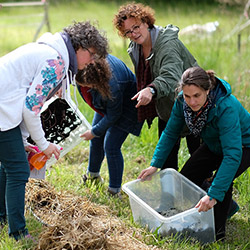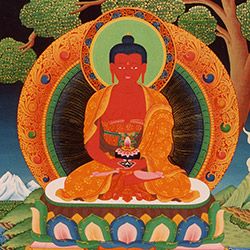Regular Practices
The Buddha taught that meditation combined with listening to the teachings and reflection leads to definitive liberation from all suffering and to enlightenment. Meditation practices can be silent, recited or chanted and with or without musical accompaniment.
The courses in Dhagpo’s program introduce us to these different meditation practices. Then it is possible to carry them out regularly, on our own or in a group, at home or at a center. At Dhagpo, they are open to all.
Below, you’ll find Dhagpo’s daily and monthly practice calendar as well as a short presentation of each practice.
Daily Practices
Dhagpo’s daily practices are recited in Tibetan in the temple.
- 7 am – Green Tara Ritual
- 6 pm – Mahakala Ritual
- 8 pm– Chenrezik Ritual (Every Friday, this practice is guided in French)
Online Meditations
Audio recordings of the Green Tara and Chenrezig meditations are available on Dhagpo’s YouTube channel.
Monthly Practices
The calendar of Dhagpo’s monthly practices is regularly updated on the French page, in the Méditation Régulières section.
Brief Presentation of the Practices

Calm Abiding (Shine)
Mind is naturally clear and peaceful. But it is not easy to remain in this state because we are constantly distracted by thoughts and carried away by emotions.
With calm abiding meditation, we train ourselves to recognize and not follow the movements that constantly cross our minds. Progressively, mind becomes more peaceful and recovers its natural clarity.
Resources
Coming soon

Chenrezig
Chenrezig represents unconditional compassion and the mantra associated with him is OM MANI PADME HUNG. Training in establishing ourselves in and remaining in the enlightened presence of Chenrezig allows for dissipating obstacles that veil the nature of mind.
Resources
• Videos

Saving Lives
This practice consists in saving animals condemned to early death. It places them under the protection of the buddhas and thus ensures them a better rebirth. This practice also increases the longevity of people to whom it is dedicated.
Resources
• Saving Lives practice
• Explainations on the implementation of the practice (in French)
• The short Chenrezik practice (in French)

The Five Sovereign Sutras
Samantabhadra’s Wishing Prayer, the Dharani of Vajravidarana, The Heart Sutra, The Sutra of Wisdom at the Moment of Death, and The Sutra of the Three Sections represent five paths: aspirations, purification, view, meditation, and renunciation. They can be recited daily or on particularly auspicious days.
Resources
• The Five Sovereign Sutras (in French) printable version
• The Five Sovereign Sutras (in French) screen version

The Sutra of Longevity
Spoken by the Buddha himself, this sutra of the great vehicle called Noble Longevity and Immeasurable Wisdom is especially efficient and carries great blessing. It has the effect of dissipating obstacles and increasing the longevity of those for whom it is dedicated.
Resources
• The Sutra of Longevity (in French)
In order to carry out these practices, it is necessary to have received appropriate instructions and be guided by a qualified teacher. Nevertheless, it is possible to attend the practices without carrying out the recitations.

Green Tara
Resources
• Videos

Amitabha

Milarepa’s Guru Yoga
A guru yoga is a meditation practice during which we unite (yoga) our mind with enlightened mind, taking an accomplished teacher (guru) of the past for our support, in this case Milarepa.
Milarepa (1052–1135 CE), an accomplished Tibetan hermit, is an example of someone who has totally turned away from harmful acts and devoted himself entirely to the practice of the Buddhist path. Having achieved enlightenment “in one body and one life,” he then shared his understanding by offering spontaneous chanting and meditation instructions to people he met.
Resources
Coming soon

Gampopa’s Guru Yoga
A guru yoga is a meditation practice during which we unite (yoga) our mind with enlightened mind, taking an accomplished teacher (guru) of the past for our support, in this case Gampopa.
Gampopa (1079–1153 CE), Milarepa’s main disciple, is considered the founder of the Dhagpo Kagyu lineage Upon the death of his wife, he vowed to devote his life to the practice of the Dharma and took monastic vows. After studying and meditating with various teachers, he actualized liberation and founded a monastic environment in the Dhagpo region.



